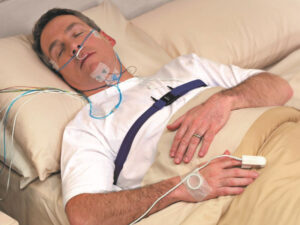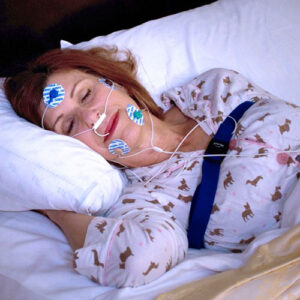What Should you Do Before a Home Sleep Study test ?
Home sleep test
What Should you Do Before a Home Sleep Study test ? Do you frequently awaken tired, perhaps with a headache or dry mouth? Do you get enough rest? Sleep apnea caused by obstruction might be to blame. Or do others frequently complain to you that you snore? After all of this, do you still doubt that there is a true issue here that requires attention? So, it’s time for you to take the sleep test at home. This occurs when your sleep is interrupted, frequently for longer than ten seconds.

A home sleep test (HST) is a quick and reliable way to determine whether you have a sleep disorder like sleep apnea. The test ensures you receive the necessary treatment for a better night’s sleep and helps identify any potential issues you might be experiencing.
But what does the sleep study test entail specifically? How do you approach it? Look at this:
What exactly is a home sleep test?
A very simple device called a home sleep test keeps track of your breathing, oxygen levels, heart rate, and breathing effort during an overnight nap. The device logs this information, and you can generate additional reports that sleep specialists can use to determine whether you have a sleeping disorder.
The first step in raising your sleep quality is to take this test. And by using the appropriate treatment techniques, this will also help you lower the health risks that are related to it.
It offers the following advantages:
-
At convenience in your own home
The HST device enables you to take the sleep study test in the comfort of your own home rather than having to remain in an unfamiliar setting.
-
Simple scheduling
There are no situations where other patients are scheduled before you for the study because the test is conducted at your home. You don’t need to schedule it; simply go to bed as you normally would.
-
Ideal for many sleep apnea cases
Patients with severe sleep apnea may find it more difficult to sleep in an unfamiliar setting. Because they can sleep on their regular schedule when taking the test at home, HST is able to record more severe apnea events without closer monitoring.
-
Effective from a financial point of view
The home sleep test is a more affordable option for assessing your sleeping patterns than a polysomnogram, which costs about one-third as much to diagnose sleep apnea.
The Day before Your Home Sleep Study
Don’t wait until the night before to get ready for your sleep study. It might be beneficial to act as though you are preparing for the test the night before. If you do this, you can use the day after to get any clarifications or answers you might need before the recording itself.

Make sure you have everything planned out so you can have a restful night’s sleep. It is best to make plans for alternative care if you are a carer or have a child who may frequently disrupt your sleep. This way, you can make sure that you get a quality recording that will give you the information you need about your potential sleep problems.
The Day before Your Home Sleep Study
If you choose a home sleep study, your doctor can assist you in selecting a device that is portable, lightweight, and user-friendly for simple self-administration. Typically, you’ll get
- Thoracic Electrodes (Soft Electrodes That Rest on Your Skin)
- An Oxygen Sensor on the Finger
- Your Breathing Measured by a Chest Belt
- Using a Nasal Cannula to Measure Airflow (Comparable to an Oxygen Mask).All of these sensors are connected to a compact unit that resembles a smartphone in size. Your sleep data are recorded by the machine. The night before performing the at-home sleep study, it’s a good idea to familiarize yourself with the tools and how to set them up. Make sure everything works as it should and that it adheres to your body. In this manner, you can get any issues resolved or last-minute inquiries addressed before the test begins. Additionally, make sure the equipment is properly removed by checking what to do the morning after your test.
What Legitimizes a Sleep Study for You?
The best way to determine if you have a sleep disorder is to participate in a sleep study. This investigation is used to identify sleep apnea. An overnight sleep study collects information on a person’s sleep patterns, including its duration and quality. The in-lab study records information such as heart rate, brain waves, breathing rate, and eye and leg movements.
Getting Ready for a Sleep Study
- A sleep study test will require some preparation from you.
- Before the sleep study, be sure to tell the techs about any medications you are taking.
- Prior to the test, stay away from caffeine-containing beverages and alcohol as these substances may affect the results.
- Things you typically use before going to bed, like a toothbrush, toothpaste, pyjamas, and a favorite blanket, should be packed in an overnight bag. As the time for the sleep study draws near, these items can make you feel more at ease.
- Plan the sleep study to coincide with your usual bedtime. You will slumber more quickly during the study if you do this.
- Take no naps. If you nap, you might be too awake to successfully complete the sleep study.
- On the day of the sleep study, refrain from using hair oils, gels, or sprays. The electrodes used to measure and monitor your sleep patterns may be affected by these substances.
- While you are undergoing the sleep study, try to make your sleeping space as cozy as you can.
Ask your doctor or sleep specialist if an at-home sleep study might be appropriate if you’re interested in one. The best person to decide whether the data from a home sleep study can accurately assess your sleep issues or whether the wider range of measurements from an in-lab sleep study would be more beneficial is a doctor.